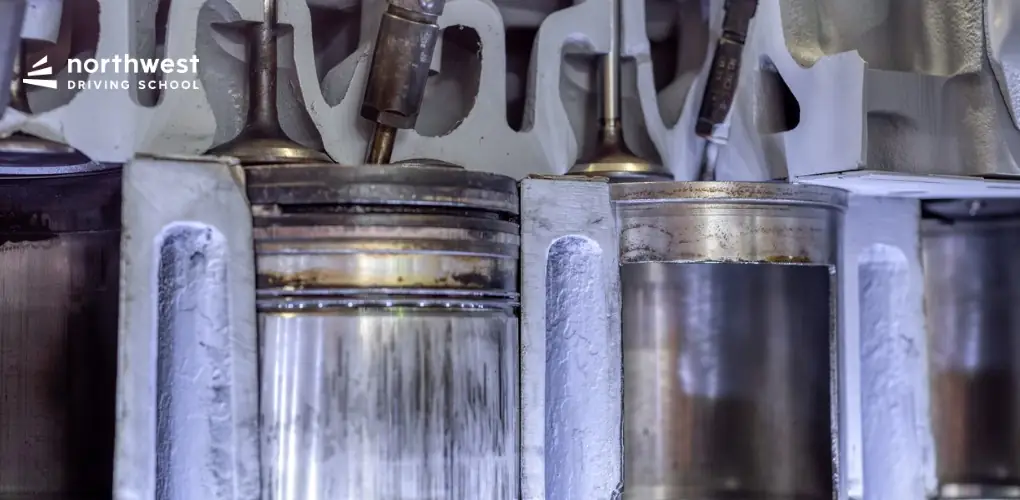- Others
How Does An Internal Combustion Engine Actually Work?

Every year, around 222 million people in the United State drive a huge range of vehicles. Nearly all of those vehicles are powered by an internal combustion engine. However, a recent survey by the AA has indicated that only 10% of drivers can actually describe, in broad terms, how an internal combustion engine works.
If you are just realizing that you’re not one of that 10%, don’t worry we’ve put together a brief description of the amazing process your car uses to actually move.
Learn More: How Your Engine Works
Table of Contents
The Basics
Combustion, also known as burning, is the basic chemical process of releasing energy from a fuel and air mixture. In an internal combustion engine, the ignition and combustion of the fuel occur within the engine itself.
The engine then partially converts the energy from the combustion to work. The engine consists of a fixed cylinder and a moving piston. The expanding combustion gases push the piston, which in turn rotates the crankshaft. Ultimately, through a system of gears in the powertrain, this motion drives the vehicle’s wheels.
The Different Types Of Internal Combustion Engine
The two most common types of internal combustion engines are the spark-ignition gasoline engine and the compression ignition diesel engine. These engines are specifically designed to work with either gasoline or diesel, which is why using the wrong fuel in your vehicle can cause significant damage to the engine.
In a spark-ignition engine, the fuel is mixed with air and then inducted into the cylinder during the intake process. After the piston compresses the fuel-air mixture, the spark ignites it, causing combustion. The expansion of the combustion gases pushes the piston during the power stroke.
In a diesel engine, only air is inducted into the engine and then compressed. Diesel engines then spray the fuel into the hot compressed air at a suitable, measured rate, causing it to ignite.
Most internal combustion engines are four-stroke cycle engines, meaning four piston strokes are needed to complete a cycle. The engine’s cycle is made up of four distinct processes. These are the intake, compression, combustion and power stroke, and exhaust.
The Development Of The Internal Combustion Engine
Rather than one significant development, the internal combustion engine came about through a series of incremental changes to established patents. The first commercially successful internal combustion engine was created by Étienne Lenoir around 1860.
Lenoir’s experimentation with electricity led him to develop the first internal combustion engine which burned a mixture of coal gas and air ignited by a “jumping sparks” ignition system by Ruhmkorff coil.
What we might consider the first modern internal combustion engine was created in 1876 by Nicolaus Otto. The Otto engine is a large stationary single-cylinder internal combustion four-stroke engine. The engines were initially used for stationary installations, as Otto had no interest in transportation and were eventually developed for vehicles by Gottlieb Daimler.
Otto actually based his engine on an 1872 commercial liquid-fuelled internal combustion engine invented by American George Brayton.
While internal combustion engines are most commonly associated with vehicles, the term internal combustion engine can also be applied to guns, rockets, or really anything that harnesses the power of an explosion to generate energy or momentum.
In recent years, the dominance of gasoline and diesel as the primary fuels of vehicle engines has been challenged by greener fuels such as biodiesel, bioethanol, hydrogen, and ethyl tert-butyl ether (ETBE). Many car manufacturers are also producing hybrid cars, which run on a mixture of traditional fuels and electricity, or, in the case of companies like Tesla, fully electric cars
Learn To Drive In Nevada Today!
The Northwest Driving School provides the Las Vegas community with live driving and traffic classes taught by seasoned instructors. All of our driving instructors have passed background checks. Each automobile is DMV safety-approved, and every member of the Northwest family is committed to providing excellent drivers ed and behind the wheel instruction.
At Northwest, you can expect to find outstanding classes, both on campus and behind the wheel, that are engaging, fact-filled, entertaining, and geared toward success.
We make no bones about it, we believe that Northwest provides the best driving lessons in Las Vegas, no matter your age or background. We are proud of the fact that 98% of our students pass their test on the first try. Call us at (702) 212-5667 to start your driving adventure with one of our expert instructors.


